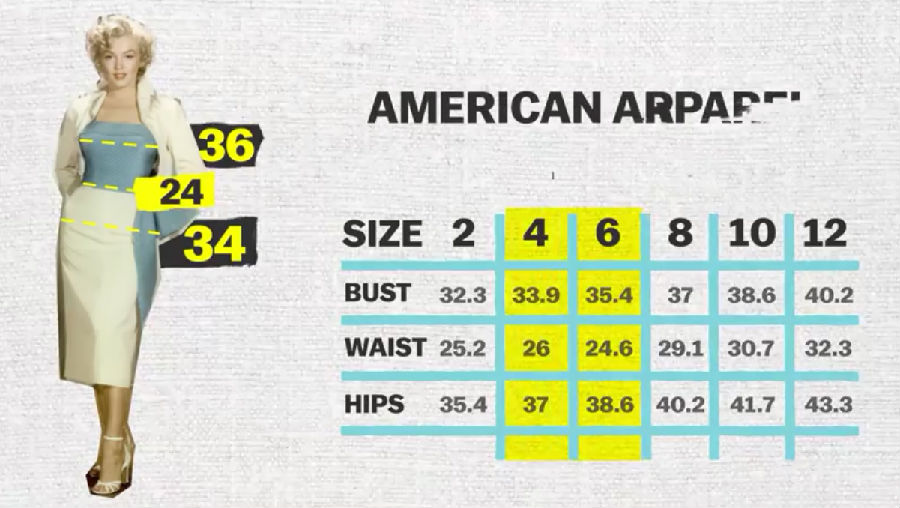Look at this note.
请大家看这张纸条。
It's from the Blue Book Modeling Agency in 1945.
这是1945年“蓝书”模特经纪公司的一张纸条。
It says Norma Jean, who you might also know as Marilyn Monroe, was in fact, a size 12.
纸条上写着诺玛·简,也就是大家熟知的玛丽莲·梦露,的尺码是12码。
She was. but back in the 50s, a size 12 was very thin.
她确实穿12码的衣服,但五十年代,12码是非常纤细的身材。
That was a model.
那是模特才有的身材。
You know, a size 12 then would be about a size 6 now.
那时的12码相当于现在的6码。
Well, to be exact, she would be a size 8 at Topshop, 6 at Zara, and 4 to 6 at American Apparel...
好吧,确切地来说,她的尺寸相当于现在Topshop的8码,Zare的6码,American Appare的4-6码……
to actually show you the inconsistencies, I went shopping.
为了更好地说明这种不协调,我还特地去逛了个街。
I bought 3 jeans at 3 different stores, all in the same size.
我在3家店买了3条同一尺码的牛仔裤。
We’re already off to a bad start. These all look different.
真是个糟糕的开始,因为这些裤子看着都不一样大。
This is not a 4.
这条不是4码。
This one is the one in the middle. This one fits!
这条,也就是中间的这条。这条刚好合适!
Hold up. It won’t zip. I give up.
大家稍等一下,拉链拉不上啊,我放弃了。
Let’s wind back a little bit.
我们把时间拨到过去。
It was the Napoleonic wars and later the Civil War in the US that demanded a sizing system for the mass production of clothing for the first time.
事实上,制定一个尺寸参考系统是在拿破仑战争(注:1803年—1815年)以及后来的内战时期(注:1861年-1865年)才显得特别必要,因为当时需要大批量生产服装。
It was for men’s uniforms.
也就是军装。
After that, men’s suit sizes were based on the chest measurement
从那以后,男装的尺寸就是按照胸围来衡量的。
and the rest was calculated accordingly, assuming that their bodies were in proportion.
其他部位则是靠相应的计算,前提是假定他们的身材都没有走样。
The demands for mass production of uniforms escalated and ready-made clothing became really popular.
大规模生产服装的需求继续上升,现成的服装也越来越受欢迎。
By the end of the nineteenth century, most people were wearing ready-made clothes.
到19世纪末,大部分人穿的已经都是现成的服装了。
In 1939, the US government funded statisticians to collect the weight and 58 measurements of 15,000 women.
到了1939年,美国政府出资,让统计师们统计了1.5万名女性的体重,制定出了58个尺码。
They only used white women, even though they took measurements of women of color,
尽管他们也量了有色人种女性的尺寸,但最终还是只采用了白人女性的尺寸,
they didn’t include them in the study or the calculations.
没有把有色人种女性纳入研究或计算的范围。
The women who were most likely to be turned out for these studies were the poor women because they would be paid.
然而,那时接受研究的往往是白人中的穷人,因为她们是为了拿到报酬才参与研究的。
So I think the data set even back then was possibly malnourished women,
所以我觉得, 那时的数据可能都是营养不良的女性,
certainly poor women, and not very diverse group of women… and that’s what we started with.
至少肯定是穷人女性,采样范围不够广泛……这是第一点。

They were looking for key measurements that could predict the sizes of other parts of the body,
他们想获得的是能够帮助预测身材其他部位尺寸的核心尺寸,
the way chest sizes had for men.
比如男性的胸围。
But women’s bodies, with variable breast and hip sizes, were much harder to summarize with a single number.
但不同女性胸部和臀部的尺寸差异较大,要想用女性身体某个部位的尺寸来衡量整个身体的尺寸是很困难的。
So, the data was used to create a system in 1958 with sizes from 8 to 42,
该数据于1958年被统计成了一个从8码到42码不等的标准尺码准系统,
an arbitrary number based on bust size combined with a letter for height and a plus or minus for hips.
而8和42只是按照胸围、身高和代表臀部丰满程度的“+”和“-”得出的两个随机数字。
The sizing chart was really unpopular, so they made some updates,
这一尺码表非常不受欢迎,所以后来人们对其做了改进,
but finally in 1983 it was completely withdrawn.
但它最终还是在1983年被彻底取消了。
In the 1970s and 80s, companies started labeling the sizes down,
到了七八十年代,服装企业开始缩小服装尺寸的范围,
and adding lower numbers like 2, zero and now even double zero.
同时新增了2码、0码、加0码等尺码。
So the waist measurement that used to be a size 12 became an 8.
就是这样,过去的12码腰围变成了现在的8码。
Vanity sizing specifically, is when the size on the label is lowered artificially,
“虚荣尺码”,明确地来说,就是把标签上的尺寸人为缩小,
in order to tempt to get somebody to buy the garment.
从而诱惑顾客购买产品。
So you’re appealing to the person’s vanity.
也就是迎合顾客的虚荣心。
Sizing has become a marketing tool.
尺码也成了营销的手段。
I think it’s done because the women are getting bigger, we’re just addressing that.
我觉得这是因为女性的身材越来越胖了,我们所做的不过是在粉饰这一事实。
When the first standardizing chart came out in 1958
1958年发布的第一套标准尺码
it was mostly built out of malnourished, white women.
很大程度上代表的都是营养不良的白人女性。
Now, that there’s such a wide group of people to cover,
现在的尺码表要覆盖的身材范围越来越广,
the retailers are picking a certain group of people to sell to,
所以零售商们就把目标客户定在了某些特定人群上,
honing in what works with that group and what doesn’t.
只关心他们的需求。
I think we’re more aiming for our own target markets.
我觉得我们更多的是把目光放在了我们自己的目标市场上。
So, when Abercrombie & Fitch does their sizing, they’re sizing to their target market, not to me.
所以,当Abercrombie & Fitch制定他们的尺码表的时候,他们取的是他们目标市场的尺码而不是我的尺码。
And we kept tweaking that information until we sold more garments and could lower the return rate.
商家不断得歪曲这些信息,直到卖出去更多产品,同时降低退货率。
That means, even brands owned by the same company will have inconsistent sizes.
这也就意味着,即便是同一大牌旗下的小品牌之间的尺寸也会不统一。
A size 8 at Banana Republic will have the same hip size as a size 2 at the Gap.
Banana Republic的8码臀围相当于Gap的2码。
So if you get frustrated while shopping….
所以,如果你买衣服遇到挫折……
It’s not you, it’s the industry, it’s not women’s bodies, we’re fine the way we are.
不是你的问题,是行业的问题,也不是女性身材的问题,我们这样的身材挺好的。
They are just random numbers, they don’t mean anything.
衣服的尺码只是一个任意的数字,说明不了任何问题。
And if you don’t like your size, just cut it out of your clothes.
你要是不喜欢你衣服上的尺寸,剪掉就可以了。












